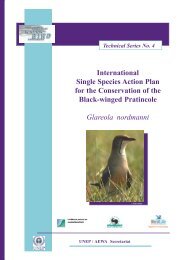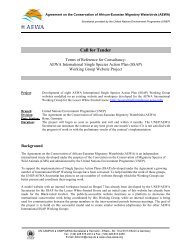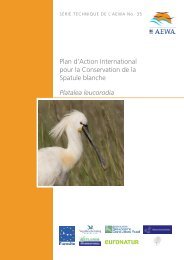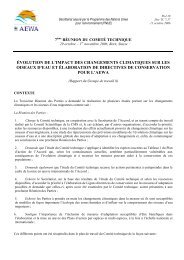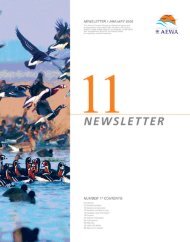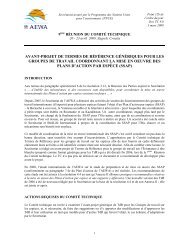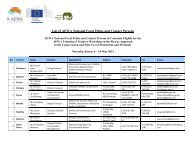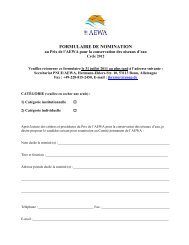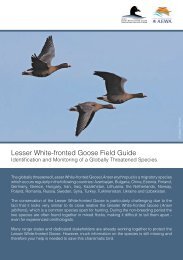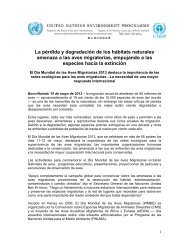International Single Species Action Plan for the ... - AEWA
International Single Species Action Plan for the ... - AEWA
International Single Species Action Plan for the ... - AEWA
Create successful ePaper yourself
Turn your PDF publications into a flip-book with our unique Google optimized e-Paper software.
<strong>AEWA</strong> Technical Series No. 36<br />
breeding area of <strong>the</strong> Fennoscandian population are discussed by Øien & Aarvak 2004. It is<br />
also important to consider that ornithological/conservation research could be an additional<br />
potential source of disturbance on <strong>the</strong> breeding grounds, unless very strictly controlled.<br />
Predation<br />
Breeding grounds<br />
Importance: Local<br />
Studies suggest that <strong>the</strong> breeding success and juvenile production of Lesser White-fronted<br />
Goose is broadly comparable to o<strong>the</strong>r goose species and that predation rates cannot explain<br />
<strong>the</strong> rapid population declines recorded. The expansion of Red Fox Vulpes vulpes and Great<br />
Black-backed Gull Larus marinus may elevate <strong>the</strong> predation threat <strong>for</strong> <strong>the</strong> Fennoscandian<br />
population and supplemented/reintroduced Swedish population, while (as <strong>for</strong> o<strong>the</strong>r geese)<br />
predation may be higher in years when small mammal prey is less abundant.<br />
There is anecdotal evidence that disturbance by White-tailed Eagles Haliaeetus albicilla and<br />
Golden Eagle Aquila chrysaetos may be having a significant impact on <strong>the</strong> small<br />
Fennoscandian population of Lesser White-fronted Goose (M. Ekker, T. Aarvak pers.<br />
comm.). American Mink Mustela vison have spread throughout Scandinavia and may also<br />
contribute to higher predation (T. Lehtiniemi, pers. comm.).<br />
Generic issues that may decrease reproductive success (i.e. those factors that pose a<br />
potential threat to geese and o<strong>the</strong>r birds in general, but <strong>for</strong> which no significant adverse<br />
impacts relating specifically to Lesser White-fronted Geese are known; all are <strong>the</strong>re<strong>for</strong>e<br />
assumed to be of ‘Low’ importance)<br />
• Poor wea<strong>the</strong>r – poor wea<strong>the</strong>r conditions during <strong>the</strong> summer may lead to virtually<br />
complete breeding failure among tundra-nesting species. Effects may include latelying<br />
snow delaying access to nest sites; loss of condition among breeding adults;<br />
and/or poor survival of goslings and juveniles.<br />
• Similarly poor wea<strong>the</strong>r on <strong>the</strong> wintering grounds, with deep snow cover, may result in<br />
no <strong>for</strong>aging areas being available to geese, <strong>the</strong>reby leading to poor body condition,<br />
while unusually dry wea<strong>the</strong>r in autumn can mean that grass/cereal crops are in poor<br />
condition during <strong>the</strong> winter, again resulting in poor <strong>for</strong>aging <strong>for</strong> geese.<br />
(c) Threat factors causing habitat loss/degradation/conversion<br />
Agricultural intensification<br />
Staging/wintering grounds<br />
Importance: High<br />
Extensive areas of grassland and wetland in <strong>the</strong> staging and wintering areas have been<br />
converted <strong>for</strong> agricultural use. In particular, <strong>the</strong>re was large-scale conversion of steppe<br />
grassland to cultivation during <strong>the</strong> second half of <strong>the</strong> twentieth century in <strong>the</strong> Central Asian<br />
staging/wintering grounds, including <strong>for</strong> <strong>the</strong> production of crops such as cotton that do not<br />
provide suitable feeding <strong>for</strong> geese. Within Europe, agricultural intensification resulted in <strong>the</strong><br />
loss and degradation of staging/wintering areas in Greece.<br />
However <strong>the</strong> relationship between agricultural intensification and goose use is complex. For<br />
example, in recent decades new goose wintering areas have been identified in Tajikistan,<br />
Turkmenistan and Uzbekistan, where irrigated fields are used <strong>for</strong> <strong>the</strong> production of wheat and<br />
rice. These sites provide suitable goose staging/wintering habitat, but are subject to high<br />
hunting pressure (both legal and illegal). Never<strong>the</strong>less, <strong>the</strong>re have been notable increases in<br />
goose numbers. For example, during <strong>the</strong> mid-1980s <strong>the</strong> total number of wintering geese in<br />
Uzbekistan was assessed at only 5,000 individuals, whereas <strong>the</strong> current estimate (<strong>for</strong> known<br />
<strong>International</strong> <strong>Single</strong> <strong>Species</strong> <strong>Action</strong> <strong>Plan</strong> <strong>for</strong> <strong>the</strong> Conservation of <strong>the</strong> Lesser White-fronted Goose 31



